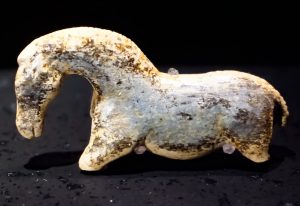
It’s clear that horses and humans have been an integral part of one anothers’ lives for a very long time. For people of European descent, the ancient nature of this relationship is visible in art such as the 30,000 year old Vogelherd horse statue from a Paleolithic site in a German cave. Very old art of this type expresses the ways that horses and Indigenous people have been interacting with each other for millennia. But somewhere along the way, several thousand years ago, the dominant culture changed that relationship. Instead of recognizing the horse as a partner, friend, family member, even Elder, humans began to see horses as “other,” as tools to use instead of fellow creatures to relate to. Tapestry’s Horse Ibachakali Program explores this ancient relationship, one still practiced today by Indigenous people but lost to the dominant culture, and teaches people how to begin reclaiming this way of relating with horses and the Land.
The most gifted leaders in many of our programs have been Mustangs, Indian Ponies, and a few special Quarter Horses and Paint horses who have come to us to do this work. Tapestry’s programs are so powerful, in part, because of the way we perceive and engage with horses. We know that horses are proud members of their own Nation. They are not human beings, and they are not mimics or imitators or mirrors of human beings, nor are they human sidekicks or merely tools for human use. Horses are our peers, in every sense of that word, with their own wisdom and their own gifts of healing and teaching. They share these with humans as much as we permit them to do so.
Over the past 25 years, Tapestry has carried out a number of projects in our Horse Ibachakali program. We’ve studied the impact of trail riding on the group meeting process, conducted a research survey within the horse community about the horse-human relationship, explored how working with horses within Indigenous worldview using mindfulness benefits sexual assault survivors, held the first horse-human relationship webinar of its kind, provided homes to wild Mustangs, and provided an experience with both gentled and wild Mustangs to women in programs and workshops of several different kinds.
Mustangs and Indian ponies, and a few horses of other types, will continue their important work in Tapestry’s programs of learning in northwestern Nebraska. Presently, they are helping the group of pan-Indigenous people and Western allies who are working together to serve, empower, and facilitate Indigenous Knowledge in IKhana Fund. Because this is a Tapestry program, the horses do this work from within their own — the horses’ own — Indigenous experience of reality. That is the place that humans can connect with horses, if the humans still understand and share that Indigenous wisdom innate to all living things. This, by the way (for those readers who are horse riders) is how people develop what Tom and Bill Dorrance called feel.
*Yakoke (thanks) to Dora Wickson of the Choctaw Language Program, Choctaw Nation of Oklahoma, for helping us with the word we use to mean “connection.” In a detailed conversation with Dora and other Choctaw language speakers in the program, the word Ibachakali was suggested as closest to the specific sense of “connection” to which we wish to refer. The type of connection described by Ibachakali is one of unity: the way that the trees of an aspen grove, for example, are connected because they all grow from a single source underground. It is a fundamental and deep-seated connection that manifests an underlying unity. You can hear a sound file of how the word Ibachakali is pronounced here.
